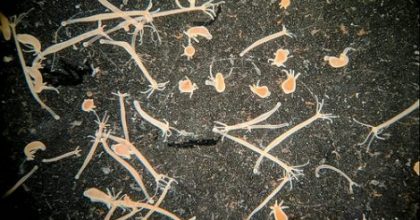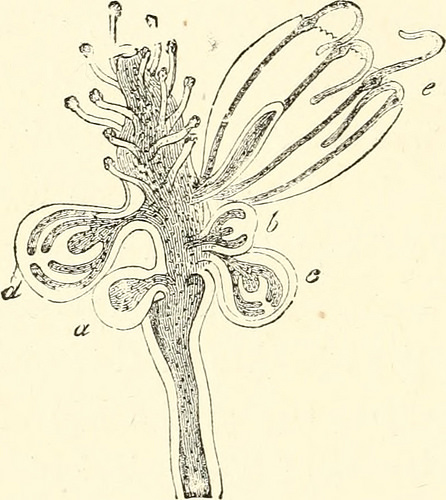
 )
)Homonculi, animalcules, and hydra! O my! Sure, planets and moons and clockworks are interesting, important, and historically significant to the faith and science conversation. But start talking about morphallactic regeneration and now you’ve really got the attention of this biologist. This week, Thomas Broman introduces a significant dose of eighteenth century biology even if the chapter title “Matter, Force, and the Christian Worldview in the Enlightenment” doesn’t really suggest as much. In part that’s because Broman is also concerned with Newton and his contributions to physics. But a bigger reason is that we aren’t eighteenth century biologists and so we don’t appreciate just how significant concepts like ‘force’ were to the subject.
If we’re being precise, arguably no one was an eighteenth century biologist, in the sense that biology wasn’t fully formed as a distinct field within natural philosophy. With that in mind, we might be less surprised to see ideas applied widely across the study of celestial motion and living organisms. And indeed, forces are relevant to how animals move and really to all biological processes, although nowadays such topics are the concern of specialties like biophysics. Most biologists don’t spend a lot of time wondering what forces animate the animals they study; that’s a settled question at the level we’re concerned about. But a few hundred years ago, given that living organisms so obviously behaved very differently from both inanimate objects and heavenly bodies, it was reasonable to wonder if they were made of different ‘stuff’ than everything else and whether that ‘stuff’ followed its own rules.
This chapter of When Science and Christianity Meet (our current blog book club title) also introduces one of my favorite ideas from biology of yore — preformationism, or the idea that we started out as infinitesimal, fully-formed humans and have only grown bigger over time. Taken to the logical conclusion, all people have always existed, nested inside of each other matryoshka-style. The only open question within that theory was whether the little ‘us’es lived inside sperm or eggs. The idea may seem quaint or even whimsical now, but it was consistent with available observations and had some appealing theological properties. I find it to be a helpful reminder that science is not simply a progressive refinement of basically correct theories; sometimes science proposes, supports, and then ultimately rules out hypotheses that are just plain wrong.

The alternative to preformationism, which was already around as a competing view in the eighteen century (and dates back at least as far as Aristotle), is epigenesis. Epigenesis supposes that living organisms are assembled or formed in some fashion or another from materials or substance that is fundamentally ‘other’ at the beginning of the process. Our current understanding of human and all organismal development is broadly epigenetic in this sense (although epigenetics has additional connotations in modern biology). Our knowledge is still incomplete, but we now understand some of the genetic and molecular processes that transform a single cell into a dog or dogwood, including some insight into why a particular cell will yield one and not the other. Christians today generally accept that science can tell us about those processes, even though the Bible testifies that God knits us together in the womb. Nowadays, we might say the various genes, proteins and chemicals are the knitting needles God uses.
Yet as Broman explains it, during the Enlightenment there were significant shifts in our understanding of how God interacts with his creation. Newton and others developed models that described how the heavens go, doubly troubling because of the association of the heavens with God and because the Bible also ascribes that motion to God’s sustaining activity. Meanwhile, the field of biology was being invented due to new advances in understanding how living creatures, particularly animals, worked. Was God’s domain shrinking with each theory? Certainly for some, the answer was ‘yes’ creating an urgency to either refute the science in God’s name or push science further to finish the job. Other theologies had been and remain available that allow mechanistic descriptions to exist alongside God’s intentions, but either/or dichotomies have a certain intuitive appeal.
It’s interesting how much our understanding of biology has changed in two-plus centuries, yet some of the same theological concerns remain. Nowadays, evolutionary biology is most likely to raise questions, but at their heart the questions are the same. Are our scientific models accurate accounts of cause and effect or just convenient frameworks for analysis? If forces are a cause of the effects we observe, are they sufficient or do they allow for God’s agency? Does God establish laws and then let them play out? Does he make constant adjustments? The various answers have different appeals. While I personally favor an approach wherein our scientific models describe God’s activity so that further inquiry reveals more about him rather than less, I’ll grant that it’s easy to assert and harder to grasp.
That seems like a good place to open up the discussion. I’d be curious to hear from you:
- How do you reconcile (or not) scientific accounts of cause and effect and the concept of God’s agency?
- How does the idea of a human soul and human agency fit into that understanding of cause and effect?
- Do the spirit of God, the human soul, and the possibility of animal souls (or “soulish” animals, as some put it) differ in degree, or in kind?
I hope you are finding this book exploration fruitful, and that you can join us next week for a look at Noah’s Ark.
Andy has worn many hats in his life. He knows this is a dreadfully clichéd notion, but since it is also literally true he uses it anyway. Among his current metaphorical hats: husband of one wife, father of two teenagers, reader of science fiction and science fact, enthusiast of contemporary symphonic music, and chief science officer. Previous metaphorical hats include: comp bio postdoc, molecular biology grad student, InterVarsity chapter president (that one came with a literal hat), music store clerk, house painter, and mosquito trapper. Among his more unique literal hats: British bobby, captain’s hats (of varying levels of authenticity) of several specific vessels, a deerstalker from 221B Baker St, and a railroad engineer’s cap. His monthly Science in Review is drawn from his weekly Science Corner posts — Wednesdays, 8am (Eastern) on the Emerging Scholars Network Blog. His book Faith across the Multiverse is available from Hendrickson.

Leave a Reply